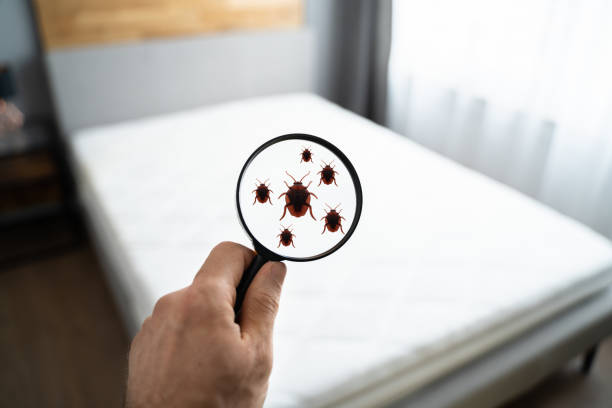Have you recently noticed strange bites on your body? Do you feel itchy and uneasy first thing in the morning? If that’s the case, you might have an infestation of bed bugs. Although they are small, bed bugs can cause significant issues if not eliminated.
They can be hard to spot because they can conceal themselves in seemingly innocuous places like upholstery, bedding, and clothing. But there are some easy ways to check yourself for bed bugs.
In this article, we’ll discuss these techniques and offer advice on how to handle a bed bug infestation if you ever come across one. Let’s dive in right now!

How Can I Test Myself For Bed Bugs?
There are a few straightforward approaches that you can take to determine whether or not you have bed bugs. The following are some of the steps of bed bug inspection:
Inspect Your Bedding
The first step in finding bed bugs is to inspect your bedding. Bed bugs are microscopic insects that can be found in your mattress, box spring, and other bedding if you don’t regularly inspect these items. Here are some things to look for when inspecting your bed for bed bugs:
- Remove all the bedding from your bed, including sheets, pillowcases, and covers.
- Look for any bloodstains or dark spots on the bedding, which could indicate bed bug fecal stains or crushed bed bugs.
- Look for bed bug exoskeletons, which are tiny, translucent shells that bed bugs shed as they grow.
- Use a flashlight to inspect the seams and crevices of your mattress and box spring. Look for any live bed bugs, eggs, or fecal stains.
- If you have a bed frame, inspect it for any signs of bed bugs, including live bugs, eggs, or fecal stains.
- Consider using bed bug traps, which can be placed under your bed or in other areas where you suspect bed bugs may be hiding.
If you inspect your bedding regularly, you can catch bed bugs early, before they can move throughout your home and cause a major infestation. The prevention of an infestation requires prompt intervention in the event of a bed bug discovery.
Check Your Furniture
It’s crucial to inspect your furniture for bed bugs because they may hide almost anywhere. Checking for bed bugs on furniture can be done by following these steps:
- Use a flashlight to inspect the seams and crevices of your furniture. Bed bugs like to hide in dark, tight spaces, so pay close attention to any cracks or crevices.
- Look for any bloodstains or dark spots on your furniture, which could indicate bed bug fecal stains or crushed bed bugs.
- Check any upholstered furniture, including couches, chairs, and loveseats, for signs of bed bugs. Use a stiff brush to scrape any bugs or eggs out of the fabric.
- Inspect any wooden or metal furniture, including dressers, nightstands, and bed frames, for signs of bed bugs. Look for live bugs, eggs, or fecal stains.
- Consider using bed bug interceptors, which can be placed under the legs of your furniture to trap any bed bugs that try to crawl up.
If you discover bed bugs in your home, you must act quickly to eliminate them. Infestations of bed bugs can quickly become widespread, making it difficult to get a good night’s rest and even worse for your health. To thoroughly eradicate the infestation, it may be necessary to engage a professional exterminator.
Use Bed Bug Traps
Infestations of bed bugs can be detected and tracked with the help of bed bug traps. These traps are effective because they lure the pests into a sticky or pitfall trap from which they cannot escape. The use of bed insect traps should go as follows:
- Place the traps near your bed or other areas where you suspect bed bugs may be hiding, such as furniture or baseboards.
- Follow the instructions provided with the traps carefully. Some traps may require you to add a lure or bait to attract bed bugs.
- Check the traps regularly for any signs of bed bugs, including live bugs, eggs, or fecal stains.
- If you do find bed bugs in the traps, it’s important to take immediate action to eliminate them before the infestation grows.
Together with other techniques of bed bug control, such as vacuuming, steaming, and the application of insecticides, bed bug traps are an effective early detection tool.
But it’s vital to remember that traps might not be adequate to get rid of a bed bug infestation on their own. Getting in touch with a professional exterminator is essential if you think you have a bed bug infestation.
Conduct A Visual Inspection
Infestations of bed bugs can be detected and tracked with the help of bed bug traps. These traps are effective because they lure the pests into a sticky or pitfall trap from which they cannot escape. The use of bed insect traps should go as follows:
- Use a flashlight to inspect your mattress, box spring, and bedding for any signs of bed bugs, including live bugs, eggs, or fecal stains.
- Check any furniture near your bed, including dressers, nightstands, and chairs, for signs of bed bugs.
- Look for any cracks or crevices in the walls or baseboards near your bed where bed bugs could be hiding.
- Inspect any luggage or bags you’ve recently used for any signs of bed bugs. Bed bugs can easily hitch a ride on clothing or other belongings.
- Consider using a magnifying glass to get a closer look at any suspicious spots or stains.
- If you do find bed bugs, it’s important to take immediate action to eliminate them before the infestation grows.
Together with other techniques of bed bug control, such as vacuuming, steaming, and the application of insecticides, bed bug traps are an effective early detection tool. But it’s vital to remember that traps might not be adequate to get rid of a bed bug infestation on their own.
Getting in touch with a professional exterminator is essential if you think you have a bed bug infestation.
Hire A Professional
Seek the assistance of a qualified exterminator if you think you may have a bed bug infestation. Bed bugs are notoriously hard to get rid of, and DIY methods of elimination are typically ineffective or even counterproductive. A professional exterminator can assist you in eliminating bed bugs in the following ways:
- Inspection: A professional exterminator will conduct a thorough inspection of your home to determine the extent of the infestation and identify the areas where bed bugs are hiding.
- Treatment plan: Based on the inspection, the exterminator will develop a treatment plan tailored to your specific needs. This may include a combination of insecticide treatments, heat treatments, and other methods.
- Treatment: The exterminator will apply the appropriate treatments to eliminate the bed bugs and prevent them from returning. They may use various methods, including liquid insecticides, dust, and heat treatments.
- Follow-up: After the initial treatment, the exterminator will schedule follow-up visits to ensure that the bed bugs have been eliminated and to monitor for any signs of a re-infestation.
- Prevention: The exterminator will also provide advice on how to prevent future bed bug infestations, such as using bed bug-proof mattresses and box spring encasements and regularly inspecting your home for signs of bed bugs.
In most cases, the best way to get rid of bed bugs is to hire a professional exterminator. They’ve got the know-how and tools to get rid of the pests and keep them from coming back. Don’t wait to call in the experts if you think you could have a bed insect problem.
Conclusion
The first step in preventing and getting rid of a bed bug infestation is a self-test. You may find and eliminate bed bugs before they become a major problem by following the advice in this article, which includes performing a visual inspection, examining your bedding and furniture, utilising bed insect traps, and calling a professional exterminator.
Bed bugs can be tough to remove once they have taken root, so it’s crucial to be thorough and proactive in your attempts to avoid and eliminate them. However, with the help of inspection and treatment, you can return to a bedbug-free environment and get some rest.
